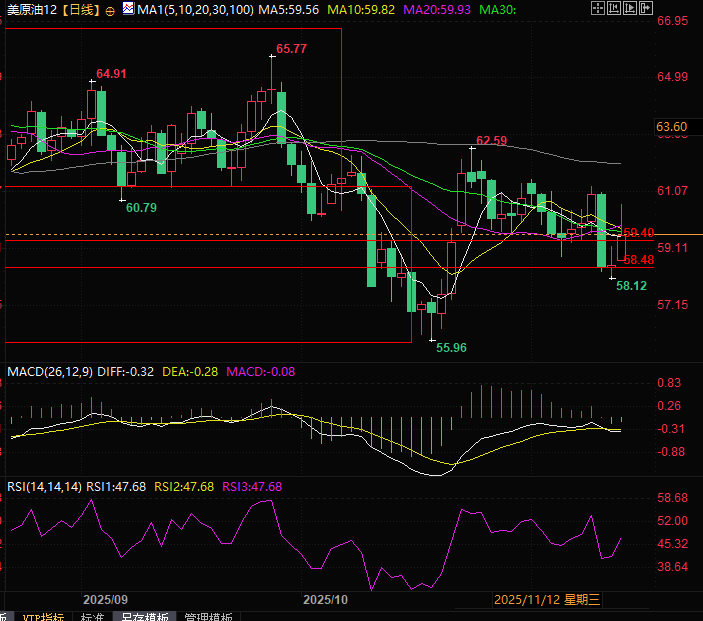Drone attack on Black Sea port deals a major blow to Russian oil, with prices battling bulls and bears at the $59.40 mark.
2025-11-14 16:08:28
Ukraine's drone attack on Novorossiysk, a key port on the Russian Black Sea and a major hub for Russian oil exports, has fueled concerns about potential disruptions to crude oil supply amid a recent sluggish market, driving oil prices up rapidly.
Russian local authorities have confirmed that the attack caused varying degrees of damage to a ship, apartment buildings around the port, and an oil storage facility, and that three crew members on board were injured in the attack.

Ukraine's escalating offensive strategy raises concerns about oil supply.
Recent trends indicate that the Ukrainian military has significantly increased its attacks on Russian oil refining, storage, and export infrastructure, primarily relying on drones and missiles for precision strikes.
The European Policy Analysis Centre points out that Ukraine's attack strategy has undergone a key shift: "From small-scale attacks on oil storage tanks in the past, to focusing on attacking the core equipment of oil refineries—especially critical components such as cracking units that are difficult to replace quickly. These are mostly Western-made and cannot be replenished through conventional channels due to recent restrictions imposed on Russia by Western countries."
From a market impact perspective, if Ukraine continues its deep strike operations and the extent and degree of damage to Russian energy infrastructure expands, leading to a cumulative effect of losses, then the supply-side risks facing the global crude oil market will substantially increase, potentially providing sustained support for oil prices.
Restrictions on Russian oil giants trigger a chain reaction in the market.
It is worth noting that the US's reinstatement of restrictions on Russia further suppresses Russia's oil supply capacity. Among these, the most significant impact on the market comes from the new restrictions targeting Russia's two major oil giants, Rosneft and Lukoil.
The measure, which will officially take effect on November 21, explicitly prohibits transactions with the two companies mentioned above, highlighting the continued escalation of pressure exerted by the US government on Russia.
Lukoil PJSC has initiated a plan to lay off employees in its global oil trading sector, just days before the new sanctions officially take effect on November 21 – a move that is the first clear and explicit signal of the restrictive measures that are about to be implemented.
Russian oil export supply chain under pressure: shipping delays and procurement suspensions exacerbate the situation.
Analysts further pointed out that due to the restructuring of shipping routes and delays in unloading processes, nearly one-third of Russia's seaborne crude oil exports may be stuck in a "tanker blockage" situation, and the suspension of Russian crude oil purchases by India and China is further amplifying this supply chain bottleneck.
Long-term fundamentals are weak, and the global crude oil supply surplus is becoming more prominent.
However, it should be noted that oil prices will still be under pressure from multiple negative factors: the International Energy Agency (IEA) has clearly warned that the global crude oil supply glut will continue to widen. Although the agency predicts that oil consumption demand will continue to grow until 2050, it still expects global crude oil production to exceed demand by 2.4 million barrels per day this year, and this supply-demand gap will further widen to 4 million barrels per day in 2025. As a result, market bearish sentiment remains high.
From the supply side, OPEC+ (the Organization of the Petroleum Exporting Countries and its allies), with Russia as its core member, has been continuously releasing production capacity since April. Coupled with the additional supply from the two major oil-producing countries, the United States and Brazil, this has exacerbated market concerns about oversupply, thus putting continuous downward pressure on oil prices.
According to calculations, OPEC's latest monthly report shows that the global crude oil market will have a slight surplus of about 20,000 barrels per day in 2025—a substantial shift in supply and demand expectations compared to the significant supply gap previously anticipated by the market.
However, it is worth noting that the overall fundamentals of the international crude oil market remain weak: on the one hand, US crude oil inventory data continues to grow, reflecting weak demand recovery; on the other hand, several institutions have issued warnings that the global crude oil market may face a serious oversupply situation in 2026, and long-term bearish pressure remains.
Technical Analysis:
Oil prices fell to the key support level of 58.48 due to the report, but coincidentally, a series of positive news led to a rapid recovery in oil prices over the next two days, indicating that the divergence between bulls and bears remains intense. Currently, oil prices continue to hold above 59.40, and are expected to continue to fluctuate within a range around 59.40.
The current resistance level is around 59.81, which is the 50% retracement level of Wednesday's bearish candlestick. Support levels remain at 59.40 and 58.48.
It is worth noting that the narrative of crude oil oversupply is talked about every day, yet oil prices have continued to hold key levels. There may be mysterious buyers behind this, and the mystery will eventually come to light.

(US crude oil December futures contract, source: FX678)
At 16:00 Beijing time, the December futures contract for US crude oil was trading at $59.62 per barrel.
- Risk Warning and Disclaimer
- The market involves risk, and trading may not be suitable for all investors. This article is for reference only and does not constitute personal investment advice, nor does it take into account certain users’ specific investment objectives, financial situation, or other needs. Any investment decisions made based on this information are at your own risk.





















